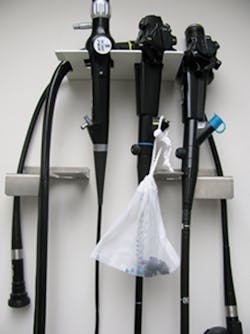Storing scopes properly and keeping cool in the SPD
Submit your questions: email: [email protected]
Q We recently went through a mock accreditation survey and were told that we need to find a better way to store our clean flexible scopes. After cleaning our scopes, they are placed on a towel and stored in a covered tote box. When a scope is needed the clean scope is removed from the tote box and then soaked in Cidex before use. Why is this process problematic?
A Your current method for storing scopes is not an acceptable practice. When coiling scopes as you are doing there is a possibility that moisture will be retained inside the various channels in the scope, which could become a source for microbial growth and contamination. The towel you are using could also retain moisture draining from the scope. The closed storage container provides an ideal breeding ground for bacteria being, dark, moist and warm. Scopes should be disinfected or sterilized immediately following the cleaning process. The longer the time lapse between cleaning and disinfection the greater the potential for microbial growth. If the microbial bio burden is too great than the efficacy of the disinfection or sterilization process would be questionable. There is also a greater chance of damaging a scope which is stored in this manner. Current recommendations and standards for the storage of flexible scopes state:
There are various parts containment products available to accommodate this need. (See figure 1.)
Q The summer months are about to start, and my staff is already dreading the extremely unpleasant working conditions in our decontamination area and their anticipation that the heat will even be more intolerable this year. During this past year our new infection control coordinator has implemented many changes in our PPE attire such as impervious gowns, lined gloves, long shoulder length plastic sleeves, knee high impervious leggings, and wider face shields. I understand the importance and value of PPE but it all just further rises the heat and body temperatures. Our facility engineers claim that our HVAC is performing at an optimum condition which is in compliance with the standards at the time it was installed and that there is no way to adjust its performance. It is hard enough to get qualified people to work in in SPD and especially in the decontamination area. In the past, I have experienced greater staff turnover and higher absences during the summer months. Any advice on how I might be able to deal with this situation?
A I fully appreciate your dilemma and it is one familiar to most sterile processing personnel. Wearing the appropriate PPE in accordance with OSHA regulations is essential to staff safety and wellbeing. There are times when I have seen personnel in the decontamination area wearing excessive PPE. Some department dress code policy requires staff to don the maximum level of PPE while working in decontamination regardless of their duties.
Take rest periods when:
- Temp or humidity rises
- Wearing heavy PPE
- Heavy work load
- No air circulation
Wearing cooling devices (see figure 2):
- Bandana
- Scull cap
- Head bands
- Scarf
- Cooling vest
About the Author

Ray Taurasi
Ray Taurasi is Principal, Healthcare CS Solutions. His healthcare career spans over five decades as an Administrator, Educator, Technologist and Consultant. He is a member of AORN, SGNA, AAMI and a past president of IAHCSMM. Taurasi has been a faculty member of numerous colleges teaching in the divisions of business administration, nursing, and health sciences. He is the author of numerous articles and textbook chapters; he is a frequent speaker at national and international healthcare conferences.
Note to readers from Ray Taurasi - In 2021, my life’s career path will transition to one of new opportunities and adventures. As a result, after nearly 19 years and 225 CS Solution columns, this edition will be my last.
“All changes, even the most longed for, have their melancholy; for what we leave behind us is a part of ourselves; we must die to one life before we can enter another.”– Anatole France
I wish you and your loved ones a healthy and joyful holiday season and a beautiful New Year! God Speed, Ray
https://www.facebook.com/pages/category/ Local-Business/Healthcare-CS-Solutions-128857 3061153887/ • email: [email protected]


